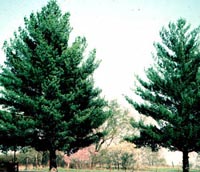Resource Library
Plant of the Week: White Pine
The University of Arkansas System Division of Agriculture does not promote, support or recommend plants featured in "Plant of the Week." Please consult your local Extension office for plants suitable for your region.
Plant of the Week
White Pine
Latin: Pinus strobus

As homeowners head out to garden centers around the state in search of living Christmas trees this month, few will realize the significant story that one of these trees — the white pine — has played in the development of our nation.
When the first Europeans arrived on our shores they were greeted by dense forests of white pine, the run-of-the-mill variety attaining 150 feet in height with 80 feet of clear trunk to the first limbs. Exceptional specimens, unfortunately the first to be cut, measured 240 feet tall and rivaled the remaining Douglas firs and redwoods of our western states. White pine lumber, and especially mast wood, became, along with tobacco and pelts, this nation’s first export items. Pre revolutionary shipping of white pine lumber to Africa was the first leg in the triad that was used in the early days of the slave trade. Ships sailing from Portsmouth, Boston or Salem took lumber to the coast of Guinea in Africa where they exchanged it for their human cargo that was taken to the West Indies where the slaves were left and sugar and rum was loaded for the return trip to New England.
The English Crown was quick to recognize the value of the white pine as masts for its sailing fleet. By the early 1700s there were laws regulating cutting of trees deemed best suited for masts. Because of its great length, light weight and high strength it was the ideal replacement for their Scotch pine masts that had to be spliced to attain the desired length.
But these laws were no more popular with the colonists than the taxation of tea, so they were widely disobeyed. Colonists would disguise themselves as Indians and cut the marked trees at night. The crown retaliated with a law that gave the land of anyone caught disguised as an Indian to the person who turned them in. In 1774, the Continental Congress stopped the export of everything, including masts, to England.
White pine occupied a range across most of New England to Wisconsin and south down the Appalachian range to North Carolina, growing best in areas where there is some winter snow. All virgin stands in the northern U.S. were cut by the end of the 19th century with the southern stands cut by World War I. Much of the momentum of the early conservation movement came because of the wanton destruction of the primeval white pine forest.
The white pine is perhaps the best landscape pine in Arkansas. It is best suited to the upland parts of the state, doing poorly in the heat and wet soils of the south. It is fast growing and typically reaches 60 feet in height with a pyramidal form and layered rings of branches that give the tree a unique symmetry.
The 50-plus year old stand at Cass along the Pig Trail show what a spectacular tree it can become. It is a five-needle pine with soft, gray-green foliage that makes an effective background planting for many landscape situations. If the tree is used as a living Christmas tree, it should only be kept inside for five to seven days and then moved outside and planted as quickly as possible.
By: Gerald Klingaman, retired
Extension Horticulturist - Ornamentals
Extension News - December 11, 1998
The University of Arkansas System Division of Agriculture does not maintain lists of retail outlets where these plants can be purchased. Please check your local nursery or other retail outlets to ask about the availability of these plants for your growing area.